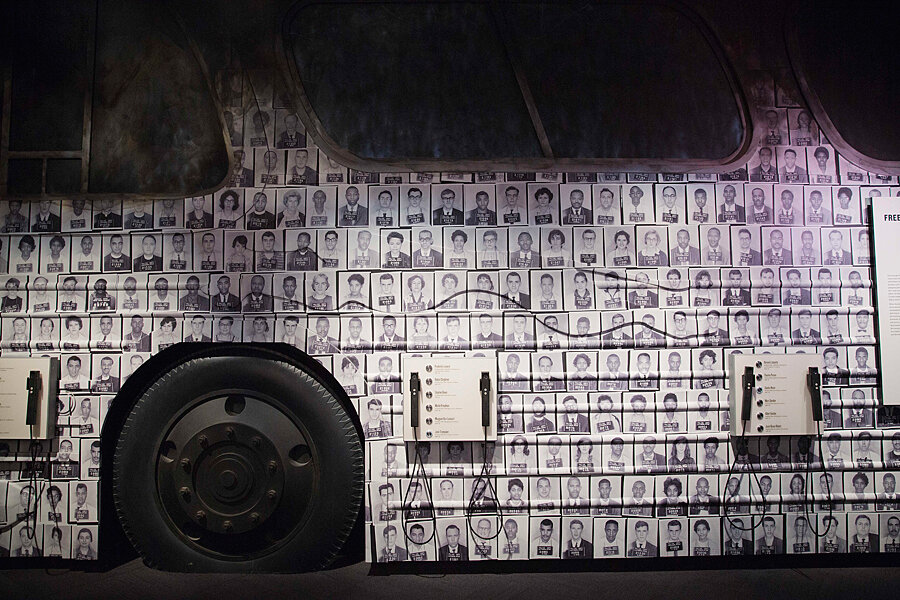As Civil Rights Act turns 50, what was role of Freedom Riders?
To commemorate Wednesday’s 50th anniversary of the Civil Rights Act of 1964, some of the original Freedom Riders – whose activism helped pave the way for the landmark law – joined 49 young students from around the US for a symbolic ride from Washington, D.C., to Richmond, Va.
“I hope that all of us – on and off this bus – will recommit ourselves to delivering the full promise of the law to all our nation’s students,” said Catherine Lhamon, the US Department of Education’s assistant secretary for human rights, in a statement. “By uniting civil rights luminaries and student leaders, we collectively renew our commitment to advancing this important work.”
For the students, dedicated to civil rights issues and chosen through a competition, the ride – this time on yellow school buses – provided an opportunity to learn first-hand from pioneers of the 1960s movement for racial equality.
The history of the 400-plus Freedom Riders shows young people that when it comes to promoting a cause, “if you are willing to do it, you don’t need many others to go along with you to make a big difference,” says Hasan Jeffries, a history professor at The Ohio State University in Columbus.
Here’s a primer on the Freedom Rides and why their actions still resonate more than half a century later:
What were the Freedom Rides?
In 1961, civil rights activists decided to challenge segregated travel rules that required blacks to sit in the back and use separate facilities at stations, frequently causing humiliation and restricting their ability to travel freely in the South. The US Supreme Court had outlawed segregation in interstate travel, but neither state nor federal authorities had enforced the equality demanded by the US Constitution.
Small groups of activists, both blacks and whites, boarded buses on routes such as Montgomery, Ala., to Jackson, Miss., sitting in sections and using facilities designated for the opposite race. Knowing they would face segregationists’ violent reactions and arrest in the South, they hoped their nonviolent resistance would impel the US government to enforce federal law and dismantle segregated travel.
Who were the Freedom Riders?
Originally, in May 1961, just over a dozen young people trained by the Congress of Racial Equality (CORE) started the Freedom Rides. As the summer progressed, they were joined by more than 400 volunteers of various racial backgrounds, male and female, Northerners and Southerners.
Among the half-dozen 1961 riders who also took part in Wednesday’s events were Charles Person and Joan Trumpauer Mulholland.
Mr. Person was the youngest of the original CORE Freedom Riders – just 18 at the time – and a gifted student who had been denied access to the Georgia Institute of Technology and instead attended Morehouse. He was severely beaten alongside other Freedom Riders in Birmingham, Ala.
Ms. Trumpauer Mulholland was a 19-year-old white student at Duke University and was arrested along with other Freedom Riders in Jackson, Miss. They were sent to Parchman state prison, but that backfired on Southern officials, causing hundreds of activists to strengthen their resolve when they refused to post bail and putting pressure on the federal government.
What did the Freedom Riders accomplish?
By the fall of 1961, the Freedom Riders had persuaded officials in the Kennedy administration of the need to intervene to end segregation in interstate travel. Bus and railway stations were stripped of their “colored only” and “whites only” signs.
“Not only did the signs come down but blacks actually sat in the front of the bus, and whites sat in the back in some cases, and they were able to go into the terminals, and to order a cup of coffee and to go into the restrooms, for the first time in their lives in many cases ... to feel like full American citizens,” says historian and Freedom Riders expert Raymond Arsenault, in a guide for teachers accompanying the PBS documentary “Freedom Riders.”
Their legacy was even broader. They showed that people of all backgrounds, including whites, were willing to make sacrifices for the cause, and their strategies and relatively quick victory served as a catalyst for future civil rights accomplishments.
“When the riders came to town, for many a community it was the first time so-called outsiders had shown a significant interest in their communities … and they arrived not as messiahs but as partners,” Professor Jeffries says.
The need to push for equality and racial harmony isn’t just historical. Another item in the news Wednesday in the county surrounding Richmond, Va.: The Ku Klux Klan has been leaving recruitment fliers on residents’ doorsteps.
This report draws from materials related to the PBS/American Experience documentary “Freedom Riders.”







